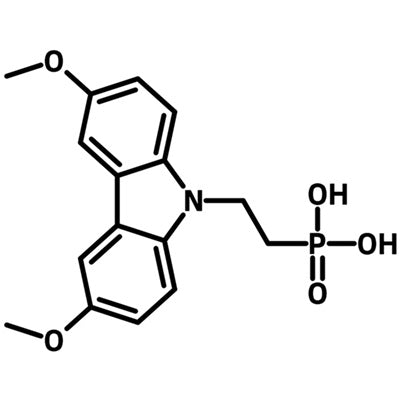MeO-2PACz
CAS Number 2377770-18-6
Charge Transport Layer Materials, Hole Transport Layer Materials, Materials, OLED Materials, Perovskite Interface Materials, Perovskite Materials,Self-Assembled Monolayer Molecule for High Efficiency Solar Cells
MeO-2PACz, hole transport or extraction layer for NFA-polymer solar cells and p-i-n perovskite solar cells
MeO-2PACz ((2-(3,6-Dimethoxy-9H-carbazol-9-yl)ethyl)phosphonic acid, CAS No. 2377770-18-6) is a small self-assembled monolayer (SAM) molecule. It is a functional derivative of the SAM material 2PACz. The structure of MeO-2PACz consists of an electron rich 3,6-methoxylcarbzole unit joined by an anchoring functional group of ethyl phosphonic acid at 9-position of the carbazole ring. This allows it to act as interface between indium tin oxide (ITO), or other metal oxides, and the photoactive layer in perovskite or polymer solar cells.
An intermediate layer of nickel oxide (NiO) between ITO and MeO-2PACz improves the surface coverage and homogeneous distribution of the SAM molecule. This is accompanied by a higher shunt resistance devices, when compared to devices without the intermediate layer.
MeO-2PACz is the optimal substrate for stabilizing black-phase FAPbI3. The resulting perovskite solar cells (PSCs) with inverted-structured show the best photovoltaic performance. With an impressive PCE of 22.13%, this is the highest efficiency of FAPbI3 based on inverted-structured PSCs. Furthermore, the best device exhibits free hysteresis and excellent long-term stability, maintaining 92% of the initial PCEs after 800 h aging under ambient conditions [1].
Serving as hole selective contact for organic solar cells and perovskite solar cells, MeO-2PACz is an alternative to PEDOT:PSS with superior performance with the convenience of solution deposition at low concentration, i.e. 1 mM.
Solution Processing Procedure
Typical processing solvents: IPA, DMF, ethanol, THF
Typical concentration: 1 mM (0.335 mg/ml) or1.0 mg/ml (1 mg MeO-2PACz is dissolved in 20 μL of anhydrous DMF, then diluted with 980 μL of anhydrous ethanol or isopropanol (IPA) to make a clear solution of 1 mg/ml in concentration)
Typical processing procedure: 40 uL of MeO-2PACz solution is deposited onto the centre of the substrate surface and spin-coated for 50 s at the speed of 3000 rpm . After annealing for 10 min at 100 ℃, the MeO-2PACz coated substrate is cooled down to room temperature and washed with IPA (60 uL) by spin-coating the IPA solvent for 30 s at the speed of at 3000 rpm. The now coated and cleaned substrate is annealed for 5 min at 100 ℃ to afford the MeO-2PACz self-assembled monolayer on the surface of the substrate.
General Information
| CAS Number | 2377770-18-6 |
|---|---|
| Chemical Formula | C16H18NO5P |
| Molecular Weight | 335.29 g/mol |
| Absorption* | λmax 465 nm (ITO) |
| Fluorescence | λem (n.a.) |
| HOMO/LUMO | HOMO = 5.30 eV, LUMO = 2.12 eV |
| Synonyms | (2-(3,6-Dimethoxy-9H-carbazol-9-yl)ethyl)phosphonic acid |
| Classification or Family | Carbazole derivatives, Self-assembly monolayers, Hole transport layer, Hole extraction layer, p-i-n Perovskite solar cells, Organic photovoltaics |
Product Details
| Purity | > 98% (HPLC) |
|---|---|
| Melting Point | Tm = 171 °C |
| Appearance | Off-white powder/crystals |
Chemical Structure

MSDS Documentation
Literature and Reviews
-
Stable α-FAPbI3 in Inverted Perovskite Solar Cells with Efficiency Exceeding 22% via a Self-Passivation Strategy, D. Zhang et al., Adv. Funct. Mater., 32 (27), 2200174 (2022); DOI: 10.1002/adfm.202200174.
-
18.4 % Organic Solar Cells Using a High Ionization Energy Self-Assembled Monolayer as Hole-Extraction Interlayer, Y. Lin et al., ChemSusChem, 14 (17), 3569-3578 (2021); DOi: 10.1002/cssc.202100707.
-
NiOx-Seeded Self-Assembled Monolayers as Highly Hole-Selective Passivating Contacts for Efficient Inverted Perovskite Solar Cells, J. Sun et al., Solar RRL, 5 (11), 2100663 (2021); DOI: 10.1002/solr.202100663.
-
Conformal monolayer contacts with lossless interfaces for perovskite single junction and monolithic tandem solar cells, A. Al-Ashouri et al., Energy Environ. Sci., 12, 3356-3369 (2019); DOI: 10.1039/C9EE02268F.
-
Operational stability, low light performance, and long-lived transients in mixed-halide perovskite solar cells with a monolayer-based hole extraction layer, R. Murdey et al., Sol. Energy Mater. Sol. Cells., 245, 111885 (2022); DOI: 10.1016/j.solmat.2022.111885.
- Enhanced Self-Assembled Monolayer Surface Coverage by ALD NiO in p‑i‑n Perovskite Solar Cells, N. Phung et al., ACS Appl. Mater. Interfaces, 14 (1), 2166–2176 (2022); DOI: 10.1021/acsami.1c15860.
Licensed by Helmholtz-Zentrum Berlin für Materialien und Energie GmbH in Germany and Kaunas University of Technology in Lithuania.

 MeO-2PACz MSDS Sheet
MeO-2PACz MSDS Sheet